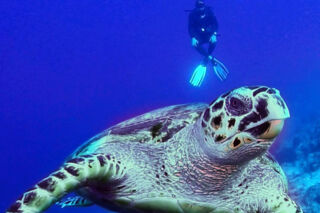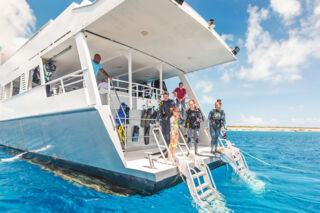Providenciales Scuba Diving
Key Points
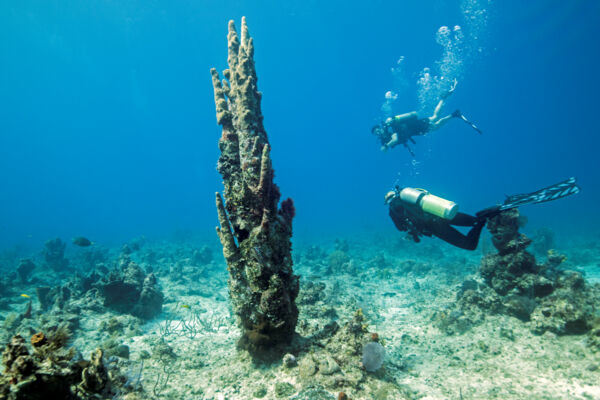
- Providenciales offers excellent scuba diving, with dive sites spread across about 70 miles (112 km) of barrier reef and wall. Snorkeling and scuba diving are some of our top recommended things to do.
- Most of the diving near Providenciales is considered wall diving, which occurs at the transition between the shallow depths on the Caicos underwater plateau and the deep water abruptly off it. In some locations, the wall is a sheer vertical face.
- The Turks and Caicos is a great place to learn to dive. We have many dive shops that have accredited and professional instructors and offer PADI and Scuba Schools International (SSI) courses.
- Dive Provo offers great rates for shared one or two-tank dives on dedicated dive boats, and always makes an effort to get to the best sites that the weather allows for. Big Blue Collective specializes in private trips, small group diving, and exploratory day trips.
Wildlife and Ecology
The Turks and Caicos is renowned for miles of exquisite barrier reefs, walls, clear waters, and abundant wildlife. Many of the dive sites accessed off Providenciales are located in protected areas, mainly in the Princess Alexandra National Park, Northwest Point Marine National Park, and the West Caicos Marine National Park.
Providenciales has the advantage of being within access to over 70 miles (112 km) of barrier reefs and walls. Because of this, there’s a huge variety of marine life and corals at the dive sites.
Locations off Grace Bay Beach tend to have spur and groove reef formations with shelves at different levels, West Caicos offers sheer edges, and some spots in the south banks even offer undercut walls! Swim-throughs, canyons and sand chutes can be found at many dive sites.
Sandbore Channel, located between West Caicos and Providenciales, is another spectacular dive site and is an amazing place for soft corals and sponges. French Cay, to the southwest of West Caicos, is also a popular place to see sharks as sightings are almost guaranteed.
As is common with the reefs in the country, coral is vibrant and reef fish are plentiful. Sea turtles, lobsters, eels, and eagle rays are common, and even the occasional dolphin can be spotted. Schools of beautiful tropical fish, such as Atlantic spadefish, yellow goatfish, horse-eye jacks, blue chromis, and bluehead wrasse can often be seen at the shallower reef sites. Conch can generally be found in shallower depths where seagrass is present.
Most of the sharks sighted around Providenciales are Caribbean grey reef sharks and nurse sharks, yet hammerheads, lemon sharks, and bull sharks are sometimes sighted, most commonly off the Northwest Point and southwest coast dive sites. During the winter months, humpback whales are sometimes seen in the deeper water off Providenciales.
There’s a spectacular range of hard and soft corals to see when scuba diving in the Turks and Caicos, including branching elkhorn coral, a wide array of star corals, brain coral, barrel sponges, tube sponges, elephant ear sponges, and gorgonian and common sea fans, to name just a few varieties.
Dive Companies
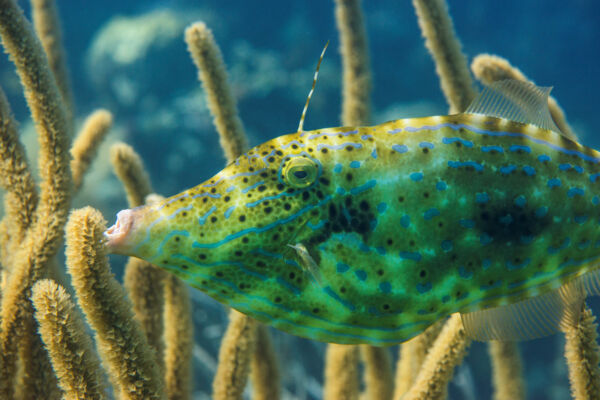
Providenciales is fortunate in having many excellent and professional dive operators. Unlike so many other dive destinations, smaller dive boats are the norm here, and groups rarely exceed twenty people. There’s typically an experienced dive master leading all dives, except in the cases where competent buddy groups prefer to explore on their own.
Dive boats tend to be busiest during the peak tourist season from December to March. This is especially the case for dive trips operated by the all-inclusive resorts. If you plan to visit during this period, we highly recommend that you reserve well in advance.
Certifications from all of the main organizations (PADI, NAUI, SSI, TDI, SDI, IANTD) are recognized by local dive companies.
All of the main dive operators on Providenciales offer the complete range of recreational dive equipment for rent and it generally tends to be good gear in good condition. Equipment sales are mostly limited to masks, fins, snorkels and accessories. All of the main dive companies offer Nitrox. Technical diving is really not supported locally.
Liveaboards
Most Turks and Caicos liveaboard trips are one week long. There are two companies that offer liveaboard diving vacations in the Turks and Caicos Islands: Aggressor Adventures Liveaboards and Explorer Ventures. Both companies' vessels depart from Providenciales.
Liveaboard diving is a great opportunity for scuba divers to enjoy unlimited diving, practice their skills, meet divers from around the world, and often get incredible photos and footage of the marine environment.
Booking and Reservations
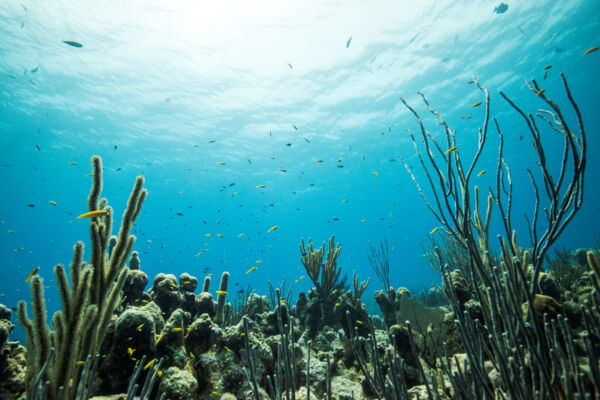
Dives can be reserved directly through a local dive operator, as part of an accommodation package, or through a reseller. For the best prices, we generally recommend you call or deal directly with a local dive company.
However, if you have already selected a place to stay, or would rather choose a different place to stay than what is included in a dive package, booking multiple dives with a dive shop will also usually result in significant discounts.
Sunny conditions will be brighter underwater, but sea creature and fish sightings can be excellent regardless of weather. It’s important to understand that bad weather typically passes quickly in the Turks and Caicos, and the forecast almost always looks worse than what the experienced conditions actually are. We advise taking the advice of your dive shop with regard to the weather forecast.
Turks and Caicos scuba diving tends to be more of a small group experience (perhaps except for the Grand Turk cruise ship excursions!) than what’s found at other Caribbean dive destinations. Private charters are usually a bit more spacious and comfortable, yet the underwater sightings do not suffer much with shared trips.
Cancellations and Bad Weather
Cancellations by divers within a few days of the dive date often incur hefty fees due to the scheduling and potential loss of revenue for the dive business. If you anticipate such an event, consult the dive operator before you book.
Due to the extensive reef system surrounding the western Caicos Islands and Providenciales, a suitable dive site can often be found despite the weather, for example on the leeward side of the island of West Caicos. However, if weather conditions restrict diving, the typical policy is to either reschedule or refund.
How to Get the Most out of Your Diving in Providenciales
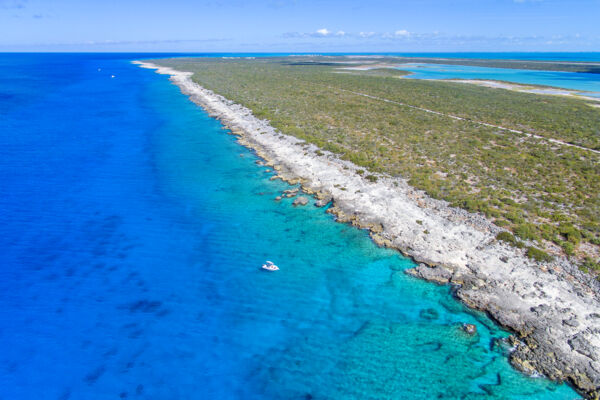
If diving is an important part of your visit to the Turks and Caicos, we recommend that guests look into the packages offered by several of the dive operators here. A multiple dive package will give you by far the best rates, and the dive company will also likely plan your dives so you’ll experience the greatest diversity of sites.
During the surface interval, it’s often possible to snorkel as many of the popular dive moorings are a bit shallower than the wall, and may be near some snorkeling sights. The West Caicos Marine National Park offers some of the bluest and clearest ocean water in the country, which is simply fun to be in. Several of the Northwest Point Marine National Park sites are within snorkeling distance of the collapsed underwater Thunderdome from a past television game show. Boats near French Cay often take the breaks between dives in the lee of the little cay, which offers excellent bird and nurse shark sightings. At any dive site, there’s also usually a barracuda hanging out around the boat to practice your photo skills on!
What’s the Best Time of Year to Dive?
The seasons do affect the dive experience a bit, with the winter months generally being the best time of year for wildlife (especially for whales), and the summer months having the nicest weather conditions (as long as a hurricane isn’t nearby!).
As may be expected, the summer months offer warmer ocean water temperatures with perfect highs of around 85° F (29.4° C) The winter months reach lows of about 77° F (25° C).
It’s best to defer to your dive operator’s judgement as they have current information and experience on the weather and ocean conditions, however, our opinion is that West Caicos, Sandbore Channel (highly weather dependent), and Northwest Point offer the best diving near Providenciales.

The Weather Forecast and Diving Conditions
Generally, sunny days with very little ocean swell and wind, and between the full and new moons, are technically the best for conditions, but it’s important to not be too concerned about the weather as rain and bad weather tend to pass quickly in the Turks and Caicos. Many sea creatures are more active in lower light conditions as well, so an overcast day can be great for unusual sightings.
The full and new moon periods tend to experience the greatest tide range, and large tide movements may reduce underwater visibility by increasing turbidity, as does ocean swell and localized wind waves as well.
The neap tides (the tidal periods with the least difference between low and high), typically occurring between the extreme phases of the moon cycle, have the least water movement and consequently better clarity.
Learning to Dive
Learning to SCUBA dive is a rewarding experience, and many beginners greatly enjoy the learning process. After a few days of interesting training, you’ll be able to discover fascinating new undersea environments and adventures.
It makes more sense to complete a course such as PADI’s Open Water Diver instead of the entry-level Discover SCUBA Diving (DSD) or other basic certification. Open Water Diver will give you a better understand of diving and allow you more options in terms of what dives you can go on and the maximum depths.
Several of the local dive operators also offer higher level courses such as NITROX, Advanced Open Water Diver, and Rescue Diver.
Underwater Photography
Underwater photography is one of the most complex and difficult forms of photography.
If you want to obtain dive or snorkeling photography gear locally during your vacation here, you basically only have two options: rent a compact digital camera with an underwater housing from a local dive company, or purchase a Go Pro with an underwater case.
Shore Diving and Wrecks
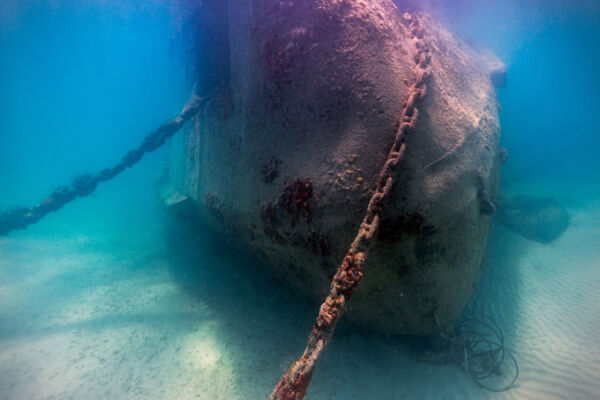
Unfortunately, Providenciales really doesn’t have many sites that are good for diving from the shore. The best spots are found off the remote Malcolm Roads Beach, which is both difficult to access and subject to offshore winds and rough conditions at times.
A lack of wrecks is another shortcoming of the Providenciales dive sites. A freighter exists off the Grace Bay barrier reef, but at 90-165 feet (27-50 m), the depth is too great for recreational diving and local dive companies do not visit the site.
More or less all of the other known wreck sites have broken up or are not easily accessible from Providenciales.
Local Businesses
